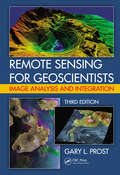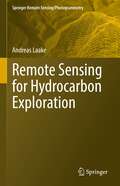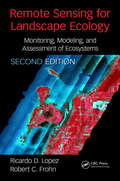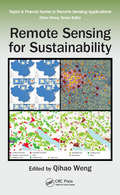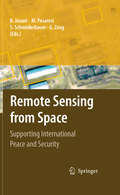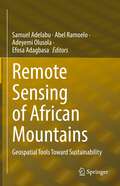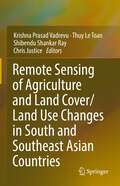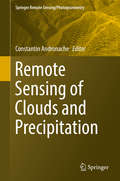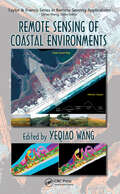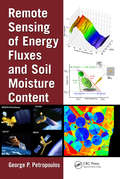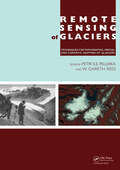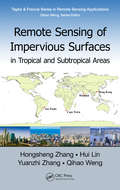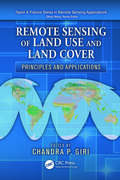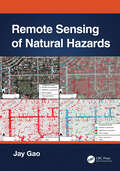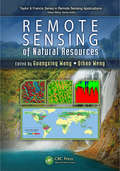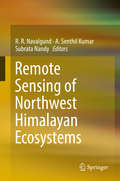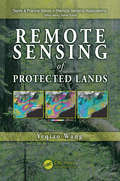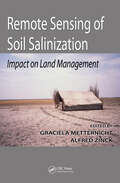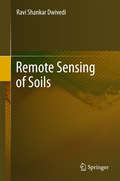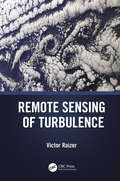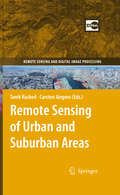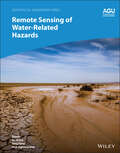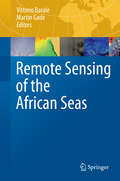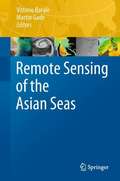- Table View
- List View
Remote Sensing for Geoscientists: Image Analysis and Integration, Third Edition
by Gary L. ProstThis third edition of the bestselling Remote Sensing for Geologists: A Guide to Image Interpretation is now titled Remote Sensing for Geoscientists: Image Analysis and Integration. The title change reflects that this edition applies to a broad spectrum of geosciences, not just geology; stresses that remote sensing has become more than photointerpre
Remote Sensing for Hydrocarbon Exploration (Springer Remote Sensing/Photogrammetry)
by Andreas LaakeThis book provides insights into the benefits of using remote sensing data from a geoscientist's perspective, by integrating the data with the understanding of Earth's surface and subsurface. In 3 sections, the book takes a detailed look at what data explorationists use when they explore for hydrocarbon resources, assess different terrain types for planning and hazards and extract present-day geologic analogs for subsurface geologic settings. The book presents the usage of remote sensing data in exploration in a structured way by detecting individual geologic features as building blocks for complex geologic systems. This concept enables readers to build their own workflows for the assessment of complex geologic systems using various combinations of remote sensing data. Section 1 introduces readers to the foundations of remote sensing for exploration, covers various methods of image processing and studies different digital elevation and bathymetry models. Section 2 presents the concept of geomorphology as a means to integrate surface and subsurface data. Different aspects of rendering in 2D and 3D are explained and used for the interpretation and extraction of geologic features that are used in exploration.Section 3 addresses remote sensing for hydrocarbon exploration in detail, from geophysical data acquisition to development and infrastructure planning. The organization of this chapter follows an exploration workflow from regional to local modeling studying basin and petroleum system modeling as well as logistics planning of seismic surveys and near-surface modeling. Aspects of field development and infrastructure planning comprise multi-temporal and dynamic modeling. The section closes with a structured approach to extracting geologic analogs from interpreted remote sensing data.The book will be of interest to professionals and students working in exploration for hydrocarbons and water resources, as well as geoscientists and engineers using remote sensing for infrastructure planning, hazard assessment and dynamic environmental studies.
Remote Sensing for Landscape Ecology: Monitoring, Modeling, And Assessment Of Ecosystems
by Ricardo D Lopez Robert C FrohnThis book provides the practical basis for the use of remote sensing to accomplish landscape ecological projects, through the merging of theory and practice, with examples. This is a specialized application and both these topics have evolved rapidly in the past decade. This evolution is not in the previous edition, and indeed this update provides much new information and valuable ideas for the professional and assist in directing the training of new personnel. The new edition will feature a combination of landscape ecology metrics, quantitative field measurements, and geospatial analyses.
Remote Sensing for Sustainability (Remote Sensing Applications Series)
by Qihao WengDriven by the societal needs and improvement in sensor technology and image processing techniques, remote sensing has become an essential geospatial tool for understanding the Earth and managing Human-Earth interactions. Remote Sensing for Sustainability introduces the current state of the art remote sensing knowledge integral for monitoring the world’s natural resources and environments, managing exposure to natural disasters and man-made risks, and helping understand the sustainability and productivity of natural ecosystems. Bridging the gap between remote sensing and sustainability science this book examines theories and methods as well as practical applications of sustainable development for cities using remote sensing; focuses on remote sensing methods and techniques for sustainable natural resources with emphasize on forests; answers questions on how and what the remote sensing methods and techniques can do for the sustainability of environmental systems; and examines the issues of energy use and sustainable energy sources using remote sensing technology in countries such as Germany, China, the U.S, drawing on case studies to demonstrate the applicability of remote sensing techniques. This comprehensive guide, which can serve to professors, researchers, and students alike, takes in consideration the United Nations set of sustainable development goals and intends to contribute to the GEO’s Strategic Plan by addressing and exemplifying a number of societal benefit areas of remote sensing data sets, methods, and techniques for sustainable development.
Remote Sensing from Space
by Gunter Zeug Martino Pesaresi Stefan Schneiderbauer Bhupendra JasaniThis volume provides the reader with an overview of the state-of-the-art Earth Observation (EO) related research that deals with national and international security. An interdisciplinary approach was adopted in this book in order to provide the reader with a broad understanding on the uses of remote sensing technologies. The book therefore comprises management aspects (issues and priorities of security research, crisis response), applied methodologies and process chains (treaty monitoring, estimation of population densities and characteristics, border permeability models, damage assessment) and the latest developments in generic tools (feature recognition, change detection and visualization). Moreover, issues of data sharing and standards, as well as new approaches to training security relevant techniques, are addressed. The contributing authors are leading researchers and experts from private companies, national research institutions and international organizations, all of whom were brought together under the aegis of the European research project GMOSS (Global Monitoring for Security and Stability). This book is tailored for the scientific community that deals with the application of EO data, as well as project managers and decision makers working in the field of security having an interest in technical solutions. The integrative use of many figures and sample images are ideal in enabling the non-technical reader to grasp quickly the modern technologies that are being researched in the area of civil security.
Remote Sensing of African Mountains: Geospatial Tools Toward Sustainability
by Samuel Adelabu Abel Ramoelo Adeyemi Olusola Efosa AdagbasaThis edited volume focuses on the use of remote sensing techniques to assess and monitor mountainous ecosystems in Africa, with a focus on tracking changes related to climate change and human activity. The book is timely, as the interaction of mountain environmental dynamics with conservation and sustainability is an under-researched issue. The chapters in this volume use remotely sensed data to study a variety of topics related to mountains and their ecosystems, including but not limited to vegetation, energy systems, environmental hazards, ecosystem services, diseases, climatic shifts, geological formations and geomorphological dynamics. The ability to monitor, assess and analyze mountainous regions is aided by the availability of remote sensing products such as optical and microwave sensors and low-cost unmanned aerial vehicles (UAVs). The works presented here push the frontier of knowledge on mountain studies and will help shape local, national and global assessments and policies, including efforts toward the achievement of the African Agenda 2063. The book will be of interest to researchers and students in remote sensing, geography, ecology and sustainability, as well as to government organizations and conservation specialists.
Remote Sensing of Agriculture and Land Cover/Land Use Changes in South and Southeast Asian Countries
by Krishna Prasad Vadrevu Chris Justice Thuy Le Toan Shibendu Shankar RayThis book sheds new light on the remote sensing of agriculture in South/Southeast Asian (S/SEA) countries. S/SEA countries are growing rapidly in terms of population, industrialization, and urbanization. One of the critical challenges in the region is food security. In S/SEA, although total food production and productivity have increased in previous decades, in recent years, the growth rate of food production has slowed down, mostly due to land use change, market forces and policy interventions. Further, the weather and climate systems in the region driven primarily by monsoon variability are resulting in droughts or flooding, impacting agricultural production. Therefore, monitoring crops, including agricultural land cover changes at regular intervals, is essential to predict and prepare for disruptions in the food supply in the S/SEA countries. The current book captures the latest research on the remote sensing of agricultural land cover/ land use changes, including mapping and monitoring crops, crop yields, biophysical parameter retrievals, multi-source data fusion for agricultural applications, and chapters on decision making and early warning systems for food security. The authors of this book are international experts in the field, and their contributions highlight the use of remote sensing and geospatial technologies for agricultural research and applications in South/Southeast Asia.
Remote Sensing of Clouds and Precipitation (Springer Remote Sensing/photogrammetry Ser.)
by Constantin AndronacheThis book presents current applications of remote sensing techniques for clouds and precipitation for the benefit of students, educators, and scientists. It covers ground-based systems such as weather radars and spaceborne instruments on satellites. Measurements and modeling of precipitation are at the core of weather forecasting, and long-term observations of the cloud system are vital to improving atmospheric models and climate projections. The first section of the book focuses on the use of ground-based weather radars to observe and measure precipitation and to detect and forecast storms, thunderstorms, and tornadoes. It also discusses the observation of clouds using ground-based millimeter radar. The second part of the book concentrates on spaceborne remote sensing of clouds and precipitation. It includes cases from the Tropical Rainfall Measuring Mission (TRMM) and the Global Precipitation Measurement (GPM) mission, using satellite radars to observe precipitation systems. Then, the focus is on global cloud observations from the ClaudSat, Cloud-Aerosol Lidar and Infrared Pathfinder Satellite Observation (CALIPSO), including a perspective on the Earth Clouds, Aerosols, and Radiation Explorer (EarthCARE) satellite. It also addresses global atmospheric water vapor profiling for clear and cloudy conditions using microwave observations. The final part of this volume provides a perspective into advances in cloud modeling using remote sensing observations.
Remote Sensing of Coastal Environments (Remote Sensing Applications Series)
by Yeqiao WangAs coastal environments around the world face unprecedented natural and anthropogenic threats, advancements in the technologies that support geospatial data acquisition, imaging, and computing have profoundly enhanced monitoring capabilities in coastal studies. Providing systematic treatment of the key developments, Remote Sensing of Coastal Enviro
Remote Sensing of Energy Fluxes and Soil Moisture Content
by George P. PetropoulosIntegrating decades of research conducted by leading scientists in the field, Remote Sensing of Energy Fluxes and Soil Moisture Content provides an overview of state-of-the-art methods and modeling techniques employed for deriving spatio-temporal estimates of energy fluxes and soil surface moisture from remote sensing. It also underscores the range
Remote Sensing of Glaciers: Techniques for Topographic, Spatial and Thematic Mapping of Glaciers
by Petri Pellikka W. Gareth ReesGlaciers and ice sheets have been melting significantly during recent decades, posing environmental threats at local, regional and global scales. Changes in glaciers are one of the clearest indicators of alterations in regional climate, since they are governed by changes in accumulation (from snowfall) and ablation (by melting of ice). Glacier chan
Remote Sensing of Impervious Surfaces in Tropical and Subtropical Areas (Remote Sensing Applications Series)
by Qihao Weng Hongsheng Zhang Hui Lin Yuanzhi ZhangRemote Sensing of Impervious Surfaces in Tropical and Subtropical Areas offers a complete and thorough system for using optical and synthetic aperture radar (SAR) remote sensing data for improving impervious surface estimation (ISE). Highlighting tropical and subtropical areas where there is significant cloud occurrence and varying phenology, the b
Remote Sensing of Land Use and Land Cover: Principles and Applications (Remote Sensing Applications Series)
by Chandra P. GiriFilling the need for a comprehensive book that covers both theory and application, Remote Sensing of Land Use and Land Cover: Principles and Applications provides a synopsis of how remote sensing can be used for land-cover characterization, mapping, and monitoring from the local to the global scale. With contributions by leading scientists from aro
Remote Sensing of Natural Hazards
by Jay GaoThis book presents a comprehensive coverage of remote sensing technology used to gather information on 12 types of natural hazards in the terrestrial sphere, biosphere, hydrosphere, and atmosphere. It clarifies in detail how to yield spatial and quantitative data on a natural hazard, including its spatial distribution, severity, causes, and the likelihood of occurrence. The author explains multiple methods of attaining data, describes the pros and cons of each method, and encourages readers to choose the best method applicable to their case. The author offers a practical approach to data analysis using the most appropriate methods and software. 1. Covers all major natural hazards including hurricanes, tornadoes, wildfires, and avalanches. 2. Studies each natural hazard holistically, ranging from spatial extent, severity, impact assessment, causes, and prediction of occurrence. 3. Explains different remotely sensed data and the most appropriate method used. 4. Compares different ways of sensing and clarifies the pros and cons of any selected data or their analysis. 5. Provides ample examples of each aspect of a natural hazard studied augmented with graphic illustrations and quality assurance information. All professionals working in the field of natural hazards, senior undergraduate, and graduate students, will find in-depth approaches and sufficient information to become knowledgeable in the methods of yielding and analyzing data provided with remote sensing technology, ultimately providing a deeper understanding of natural hazards.
Remote Sensing of Natural Resources (Remote Sensing Applications Series)
by Qihao Weng Guangxing WangHighlighting new technologies, Remote Sensing of Natural Resources explores advanced remote sensing systems and algorithms for image processing, enhancement, feature extraction, data fusion, image classification, image-based modeling, image-based sampling design, map accuracy assessment and quality control. It also discusses their applications for
Remote Sensing of Northwest Himalayan Ecosystems
by R. R. Navalgund A. Senthil Kumar Subrata NandyHimalaya, one of the global biodiversity hotspots, is the abode of a variety of flora and fauna. The Himalayan ecosystems have immense ecological, socioeconomic, and aesthetic significance as they provide a wide range of ecosystem services. The northwest Himalaya (NWH), covering three states of India viz., Uttarakhand, Himachal Pradesh, and Jammu and Kashmir, starts from the foothills of Shivaliks in the south and extends to the greater Himalaya in the north. This region is also the source of some of the major rivers of India. With the increase in population, the NWH ecosystems have been under threat due to deforestation, loss of biodiversity, expansion of agriculture and settlement, overexploitation of natural resources, habitat loss and fragmentation, poaching, mining, construction of roads and large dams, and unplanned tourism. The Himalaya being young and geotectonically active, remains inherently unstable, fragile, and prone to natural disasters. Climate change is also likely to impact the Himalayan cryosphere drastically. Recognizing the importance of the Himalaya, a National Mission for Sustaining the Himalayan Ecosystem, one of the eight missions under the National Action Plan on Climate Change (NAPCC) of Govt. of India, to conserve biodiversity, forest cover and other ecological values in the Himalayan region has been taken up.Spaceborne remote sensing with its ability to provide synoptic and repetitive coverage has emerged as a powerful tool for assessment and monitoring of the Himalayan resources and phenomena. Indian Institute of Remote Sensing, Dehradun has taken up a number of studies in the fields of geology, water resources, forestry, agriculture, urban settlement, etc., over the last decade. The book summarises the work carried out in different disciplines, illustrated with tables and figures and a host of relevant references. It is hoped that the book serves as an excellent reference of immense value to the students, researchers, professors, scientists, professionals, and decision makers working in the NWH region.
Remote Sensing of Protected Lands (Remote Sensing Applications Series)
by Yeqiao WangNational parks, wildlife refuges and sanctuaries, natural reserves, conservation areas, frontier lands, and marine-protected areas are increasingly recognized as essential providers of ecosystem services and biological resources. As debates about climate change and sustainability intensify, protected areas become more important as indicators of eco
Remote Sensing of Soil Salinization: Impact on Land Management
by Graciela Metternicht J. Alfred ZinckRecognized and advocated as a powerful tool, the role of remote sensing in identifying, mapping, and monitoring soil salinity and salinization will continue to expand. Remote Sensing of Soil Salinization: Impact on Land Management delineates how to combine science and geospatial technologies for smart environmental management. Choose the Right Tech
Remote Sensing of Soils
by Dwivedi Ravi ShankarThis book is about applications of remote sensing techniques in the studies on soils. In pursuance of the objective, the book initially provides an introduction to various elements and concepts of remote sensing, and associated technologies , namely Geographic Information System (GIS), Global Positioning System (GPS) in chapter-1. An overview of the sensors used to collect remote sensing data and important Earth observation missions is provided in chapter-2. The processing of satellite digital data (geometric and radiometric corrections, feature reduction, digital data fusion, image enhancements and analysis) is dealt with in Chapter-3. In the chapter to follow the interpretation of remote sensing data , very important and crucial step in deriving information on natural resources including soils resources, is discussed. An introduction to soils as a natural body with respect to their formation, physical and chemical properties used during inventory of soils, and soil classification is given in Chapter-5. The spectral response patterns of soils including hyperspectral characteristics -fundamental to deriving information on soils from spectral measurements, and the techniques of soil resources mapping are discussed in chapter-6 and -7,respectively. Furthermore, the creation of digital soil resources database and the development of soil information systems, a very important aspect of storage and dissemination of digital soil data to the end users are discussed in ch. apter-8. Lastly, the applications of remote sensing techniques in soil moisture estimation and soil fertility evaluation are covered in chapter-9 and -10, respectively.
Remote Sensing of Turbulence
by Victor RaizerThis book offers a unique multidisciplinary integration of the physics of turbulence and remote sensing technology. Remote Sensing of Turbulence provides a new vision on the research of turbulence and summarizes the current and future challenges of monitoring turbulence remotely. The book emphasizes sophisticated geophysical applications, detection, and recognition of complex turbulent flows in oceans and the atmosphere. Through several techniques based on microwave and optical/IR observations, the text explores the technological capabilities and tools for the detection of turbulence, their signatures, and variability. FEATURES Covers the fundamental aspects of turbulence problems with a broad geophysical scope for a wide audience of readers Provides a complete description of remote-sensing capabilities for observing turbulence in the earth’s environment Establishes the state-of-the-art remote-sensing techniques and methods of data analysis for turbulence detection Investigates and evaluates turbulence detection signatures, their properties, and variability Provides cutting-edge remote-sensing applications for space-based monitoring and forecasts of turbulence in oceans and the atmosphere This book is a great resource for applied physicists, the professional remote sensing community, ecologists, geophysicists, and earth scientists.
Remote Sensing of Urban Green Space
by Qingyan MengThis book presents a systematic study of urban green space remote sensing from multi-dimensional and multi-scale technologies. On the basis of introducing the connotation, science and application value of urban green space, this book focuses on the two-dimensional and three-dimensional information extraction technology of urban vegetation, two-dimensional and three-dimensional measurement technology of urban green space and multi-scale perception technology and discusses the remote sensing evaluation method of urban green space. By exploring the technical advantages of ‘satellite remote sensing + aerial remote sensing + near-ground remote sensing’, urban green space remote sensing promotes the development of urban vegetation research from two-dimensional to three-dimensional observation, so that the quantity, quality and human perception of urban vegetation can be measured. In each chapter, an individual technology/method is introduced, and several cases are cited to demonstrate its practical application. This book offers a valuable reference guide for practitioners in urban planning, landscape greening, environmental protection and urban management, as well as teachers and graduate students engaged in urban remote sensing research.
Remote Sensing of Urban and Suburban Areas
by Carsten Jürgens Tarek Rashed"Remote Sensing of Urban and Suburban Areas" provides instructors with a text reference that has a logical and easy-to-follow flow of topics around which they can structure the syllabi of their urban remote sensing courses. Topics have been chosen to bridge the gap between remote sensing and urban studies through a better understanding of the science that underlies both fields. In so doing, the book includes 17 chapters written by leading international experts in respected fields to provide a balanced coverage of fundamental issues in both remote sensing and urban studies. Emphasis is placed on: theoretical and practical issues in contemporary urban studies and remote sensing; the spectral, spatial and temporal requirements of remotely sensed data in relation to various urban phenomena; methods and techniques for analyzing and integrating remotely sensed data and image processing with geographic information systems to address urban problems; and examples of applications in which applying remote sensing to tackle urban problems is deemed useful and important.
Remote Sensing of Water-Related Hazards (Geophysical Monograph Series)
by Ke Zhang Yang Hong Amir AghaKouchakRemote Sensing of Water-Related Hazards Remote Sensing of Water-Related Hazards Water-related hazards such as floods and droughts have serious impacts on society. Their incidence has increased in recent decades, a trend set to continue with ongoing climate change. Adaptation and mitigation measures require accurate detection, monitoring, and forecasting, much of which comes from remote sensing technologies. Remote Sensing of Water-Related Hazards takes an interdisciplinary approach, presenting recent advances in the available data, sensors, models, and indicators developed for monitoring and prediction. Volume highlights include: Progress in remote sensing of precipitation, storms, and tornados Different techniques for flood mapping, forecasting, and early warning Integrated approach for predicting flood and landslide cascading hazards Satellite monitoring of water cycle variation, water scarcity, and drought conditions Multi-indicator and multi-sensor approaches for quantifying drought impacts The American Geophysical Union promotes discovery in Earth and space science for the benefit of humanity. Its publications disseminate scientific knowledge and provide resources for researchers, students, and professionals.
Remote Sensing of the African Seas
by Vittorio Barale Martin GadeThe African Seas include marginal basins of two major oceans, the Atlantic and the Indian, a miniature ocean, the Mediterranean Sea, and an infant ocean, the Red Sea. Understanding the wide spectrum of environmental features and processes of such a varied collection of marine and coastal regions requires that in situ observation systems be integrated and actually guided, by the application of orbital remote sensing techniques. This volume reviews the current potential of Earth Observations to help in the exploration of the marginal seas around Africa, by virtue of both passive and active techniques, working in several spectral ranges - i. e. measuring either reflected visible and near-infrared sunlight, as well as surface emissions in the thermal infrared and microwave spectral regions, or again the surface reflection of transmitted lidar or radar impulses of visible or microwave radiation. The in-depth evaluation of the advantages offered by each technique and spectral region and in particular by the development of advanced multi-technique systems, contributes to the assessment of the abundant natural resources that the Seas of Africa have to offer, of those in dear need of being - sustainably - exploited and of others that should be protected and maintained in their still pristine conditions.
Remote Sensing of the Asian Seas
by Vittorio Barale Martin GadeA wide variety of marginal basins, ranging from polar to equatorial regions, and a few sizeable enclosed basins, can all be included among the Asian Seas. The Arctic Ocean shelf seas off Siberia; the sheltered basins along the Pacific Ocean’s western rim; the coastal seas of the northernmost Indian Ocean, including the semi-enclosed Red Sea and Persian Gulf; the Caspian Sea, the remnants of the Aral Sea and a score of brackish or freshwater lakes, such as Lake Balkhash and Lake Baykal; all exhibit a multiplicity of environmental features and processes. Understanding the peculiarities of such a large and varied collection of marine and coastal types requires integrated observation systems, among which orbital remote sensing must play an essential role. This volume reviews the current potential of Earth Observations in assessing the many Asian seascapes, using both passive and active techniques in diverse spectral regions, such as measuring reflected visible and near-infrared sunlight and surface emissions in the thermal infrared and microwave range, or surface reflection of transmitted radar pulses in the microwave range. An in-depth evaluation of the available spectral regions and observation techniques, as well as of novel multi-technique methods, ensures that suitable tools are indeed accessible for exploring and managing the wealth of resources that the Asian Seas have to offer.
